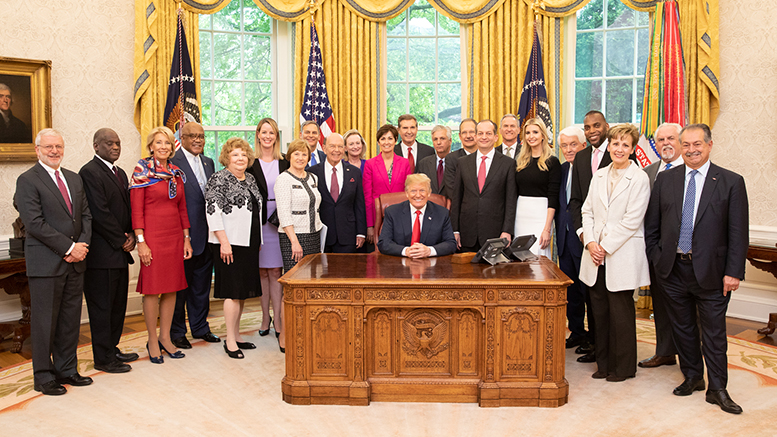A blue-ribbon task force that examined the barriers and potential of apprenticeships in workforce development is recommending a pilot program to test “industry-recognized” apprenticeships in fields that don’t have well-established registered apprenticeships.
“This would test the process for reviewing certifiers and would help the federal government better understand how to support industry groups working to develop standards and materials” for industry-recognized apprenticeship programs, according to the Task Force on Apprenticeship Expansion, which on May 10 submitted its report with recommendations to the White House.
The task force — which includes representatives from business, industry, labor, education and public officials — is co-chaired by the secretaries of labor and education. Walter G. Bumphus, president and CEO of the American Association of Community Colleges (AACC) and a member of the task force, said AACC and its member colleges are prepared to work with their partners to develop and enhance apprenticeships in order to better serve students and their communities.
During the task force’s photo op with President Trump, Bumphus highlighted for Trump the efforts of community colleges in both formal and informal apprenticeships, as well as other work-based learning opportunities.
“I was able to showcase our community colleges for their many missions and their constant evolution as they respond to the needs of their local and regional communities and businesses,” Bumphus said following the meeting.
Not used enough
A key message from the task force is that apprenticeships are underutilized in the U.S. as a workforce development tool, especially at a time when business and industry are clamoring for skilled employees to fill available jobs.
“The current half a million apprenticeships are simply not enough to fill the more than 6 million unfilled jobs at U.S. companies in today’s labor market,” U.S. Commerce Secretary Wilbur Ross, who served as vice chair of the task force, said in a statement accompanying the panel’s report.
The report highlighted various barriers to apprenticeships, including:
- Students, parents and educators — especially high school counselors — are too focused on the baccalaureate and don’t explore career and technical education options that provide pathways to good-paying trade jobs that don’t require a four-year degree.
- Industries that traditionally use apprenticeships still face the stigma that these jobs are dirty and unsafe.
- Such programs require heavy investments for companies, especially for small businesses, and they question the return on investment.
- Approval from the government for recognition as a registered apprenticeship is too burdensome for many companies.
- Many apprenticeships don’t promote opportunities for advancement for apprentices.
Although companies with registered apprenticeships are generally satisfied with the system because it offers quality control and provides diversity, less than half a percent of the workforce comes through these formal programs, according to the report.
All hands on deck
The task force offered ways to tackle these issues. For example, it called on federal investment to help expand pre-apprenticeship activities in middle and high schools for career and technical education or other educational certificates. It also suggested streamlining credit for prior learning and work experiences in apprenticeships to help participants accelerate the time to full employment.
The task force noted that addressing the barriers to apprenticeships will require full participation from all stakeholders.
“While apprenticeships are fundamentally a business investment rapid expansion of apprenticeships hinges on a cultural change across companies, colleges, high schools, labor unions, trade associations and other institutions,” Ross said.
More flexibility
Among its recommendations, the task force called to create a less formal, but still stringent federally recognized apprenticeship program that would be approved by industry. Such programs could be eligible for federal funding, which the administration has championed for during recent congressional appropriations hearings. Currently, only registered apprenticeships can tap federal funding for apprenticeships.
Industry-recognized apprenticeships should be flexible and focused on competency rather than “seat time,” the report said. This would not only keep costs down, but it would appeal to industries not traditionally known to offer apprenticeships, such as insurance and health care.
“Creating apprenticeships in fields such as graphic design, insurance claims adjustment and medical transcribing could mean nearly tripling the number of occupations commonly filled via apprenticeships for openings that employers often find difficult to fill,” the report said.
Ensuring quality
The task force recommended that industry-recognized apprenticeships — as well as other work-and-learn models — include core components to ensure the quality of such programs. One of the components would be portable credentials, such as degrees or certificates, as they serve to better connect employers and learning providers.
Industry-based governing bodies, in consultation with the Labor Department, should be responsible for developing these apprenticeship credentialing standards as well as making sure the standards are met. These certifiers should also be able to “influence or negotiate” with employers and colleges to partner on transfer or credit agreements — such as credit for prior learning — before verifying the credentialing standard.

